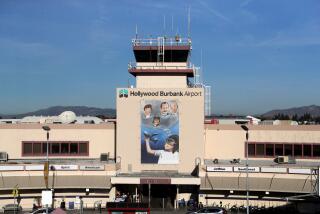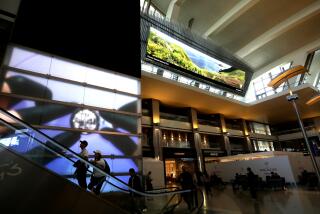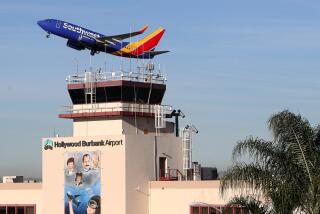Debate Flies Over Denver’s Big, New Airport : Construction: The $2.7-billion facility is twice the size of Manhattan. Despite impressive figures, a strong movement remains to stop the project and put it in mothballs.
DENVER — Cresting a low ridge on the rolling prairie northeast of Denver, the green wheat fields suddenly give way to a vast, level sweep of bare-earth horizon alive with heavy construction equipment.
It is the new and controversial $2.7-billion Denver International Airport, covering 53 square miles, twice the size of Manhattan Island.
Nearly 10,000 workers will be on the site as construction peaks this summer and the weekly payroll will exceed $6 million.
The new airport is the largest ongoing public works project in the nation and second in the world only to the “chunnel” that will connect England and France beneath the English Channel, says airport spokesman Chuck Cannon.
Once inside the construction perimeter the terrain becomes a moonscape, with pyramids of aggregate and rows of plowed bentonite clay resembling bleak lunar peaks and ridges.
The massive scale of the project dwarfs giant construction cranes so they appear like tiny praying mantises hovering about the Jeppesen Terminal and three concourses marching away to the north at quarter-mile intervals.
The rolling prairie has been planed to table-top level for runways and taxiways. An estimated 110 million cubic yards of earth will be moved--leveling hills and ridges, filling valleys and ravines--enough earth to fill a 10-by-30-foot ditch stretching from Denver to New York City.
Airline passengers will be whisked by electric-powered subway train in less than five minutes from the main terminal to distant Concourse C. The train’s capacity will be 6,000 people an hour. There will be 12,000 covered parking spots for automobiles.
Five runways are scheduled to be in operation when the airport opens in October, 1993. A sixth will open the following year. In all, 12 runways are envisioned when the airport is fully developed and capable of handling a projected 110 million passengers a year.
Despite the impressive figures, there remains a strong movement to stop the project and put it in mothballs.
Opponents say the present Stapleton International Airport adequately fills Denver’s present and future needs. They have given the project nicknames such as Denver’s Field of Dreams, the White Elephant of the Plains and Federico’s Folly in memory of Denver’s ex-Mayor Pena, who was a guiding force in launching the new airport.
In 1989, 63% of Denver’s voters gave their blessing to the new airport, at that time carrying a price tag of $1.7 billion.
Then came setbacks.
Financially stricken Continental Airlines, which with United Airlines is one of the Denver airport’s chief users, backed off from the 32 gates it originally agreed to use in Concourse A. Continental finally signed for 20 gates for five to 10 years, rather than the originally planned 20-year lease.
Standard & Poor’s, the nation’s leading bond-rating agency, dropped the Denver airport bonds to a BBB-minus rating--its lowest investment grade rating--after Continental declared bankruptcy and United still had not signed an agreement for the new airport. The rating was upgraded to BBB when United finally signed on early this year.
Last month, Denver Aviation Director George Doughty resigned unexpectedly on the eve of construction hitting its highest level.
Denver businessman Gary Oakley, chairman of the Concerned Coloradans Assn., which opposes the new airport, said opponents especially dislike the distance the new facility is from downtown Denver--28 miles, compared with Stapleton, which is seven miles away.
“It will involve 800 million more miles driven per year in the Denver area in a rarefied (high altitude) atmosphere, and the inconvenience and time involved is just not practical,” Oakley said.
He said it is not too late to stop the project.
“It’s about 26% completed. We know where there’s a wonderful airport 100% complete, wonderfully located and by FAA records one of the most efficient in the country. We cannot understand why this is being abandoned,” Oakley said.
The Air Transport Assn., the Washington, D.C.-based trade group for the major airlines, early on said there was no need for a new Denver airport. It cited shrinking traffic at Stapleton and said it anticipated that the new airport’s passenger costs would be “extraordinarily high.”
“Things have not improved since then. Domestic air travel has been flat for five years,” said Bill Jackman, vice president of the association.
United Airlines Chairman Stephen W. Wolf, whose airline has contracted to use 42 gates at the new airport’s Concourse B, recently toured the site. He was pleased with the airport’s design but said United may land fewer planes there than it has at Stapleton. Wolf asked the city to do a “prudent review” of expenditures.
Late last year, Denver City Auditor Bob Cridder said the new airport may be too costly for air travelers to use, with per-passenger costs possibly rising to $21.11. United has said the airport won’t work economically if those costs rise above $20 per ticket.
The national per-passenger average is $5 to $8.
Denver also lost its battle with nearby Front Range Airport to attract major air cargo carriers. Airborne Express, Emery Worldwide, Federal Express and United Parcel Service all signed letters of intent to use Front Range after Stapleton closes.
However, the impressive project forges ahead.
Concourse C, the smallest and most distant concourse from the main terminal, will serve all airlines except United and Continental. It stands in the shadow of the 327-foot-tall control tower, which will have 12 air-traffic controllers. Stapleton Airport’s tower is 165 feet tall and has six air controllers.
Airport spokesman Cannon said the airport’s basic design follows that of Atlanta’s new airport.
“One mistake at Atlanta we corrected: The concourses at Atlanta were too close to each other,” he said. “Two 747 jumbo jets can’t push back at the same time (from neighboring concourses) at Atlanta. Here, we left enough room so not only can two 747s push back at the same time, but also taxi both ways at the same time.”
Cannon also said the new airport is “the world’s first all-weather airport. We will be able to operate as well in a blizzard as Stapleton can on a sunny day.”
To land simultaneously on parallel runways when visibility is reduced by rain or snow, they must be 4,300 feet apart, the FAA says. Stapleton’s are about 1,600 feet apart.
“Out here, all of our runways are at least 4,300 feet apart. We can still land 90 planes per hour in a blizzard,” 10 more than Stapleton can land in perfect weather, Cannon said.
The FAA said the new airport’s north-south runways on the east side of the terminal are 5,700 feet apart, the north-south pair on the west side are 7,600 feet apart; the two initial east-west runways are separated by 13,500 feet.
More to Read
Sign up for Essential California
The most important California stories and recommendations in your inbox every morning.
You may occasionally receive promotional content from the Los Angeles Times.










